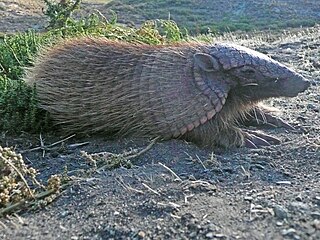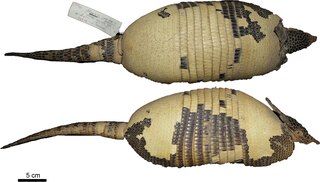
Armadillos are New World placental mammals in the order Cingulata. The Chlamyphoridae and Dasypodidae are the only surviving families in the order, which is part of the superorder Xenarthra, along with the anteaters and sloths. Nine extinct genera and 21 extant species of armadillo have been described, some of which are distinguished by the number of bands on their armor. All species are native to the Americas, where they inhabit a variety of different environments.

Xenarthra is a major clade of placental mammals native to the Americas. There are 31 living species: the anteaters, tree sloths, and armadillos. Extinct xenarthrans include the glyptodonts, pampatheres and ground sloths. Xenarthrans originated in South America during the late Paleocene about 60 million years ago. They evolved and diversified extensively in South America during the continent's long period of isolation in the early to mid Cenozoic Era. They spread to the Antilles by the early Miocene and, starting about 3 Mya, spread to Central and North America as part of the Great American Interchange. Nearly all of the formerly abundant megafaunal xenarthrans became extinct at the end of the Pleistocene.

The giant armadillo, colloquially tatu-canastra, tatou, ocarro or tatú carreta, is the largest living species of armadillo. It lives in South America, ranging throughout as far south as northern Argentina. This species is considered vulnerable to extinction.

The six-banded armadillo, also known as the yellow armadillo, is an armadillo found in South America. The sole extant member of its genus, it was first described by Swedish zoologist Carl Linnaeus in 1758. The six-banded armadillo is typically between 40 and 50 centimeters in head-and-body length, and weighs 3.2 to 6.5 kilograms. The carapace is pale yellow to reddish brown, marked by scales of equal length, and scantily covered by buff to white bristle-like hairs. The forefeet have five distinct toes, each with moderately developed claws.

The nine-banded armadillo, also known as the nine-banded long-nosed armadillo or common long-nosed armadillo, is a mammal found in North, Central, and South America, making it the most widespread of the armadillos. Its ancestors originated in South America, and remained there until the formation of the Isthmus of Panama allowed them to enter North America as part of the Great American Interchange. The nine-banded armadillo is a solitary, mainly nocturnal animal, found in many kinds of habitats, from mature and secondary rainforests to grassland and dry scrub. It is an insectivore, feeding chiefly on ants, termites, and other small invertebrates. The armadillo can jump 91–120 cm (3–4 ft) straight in the air if sufficiently frightened, making it a particular danger on roads. It is the state mammal of Texas.

The greater long-nosed armadillo is a South American species of armadillo found in Colombia, Venezuela, Ecuador, Guyana, Suriname, French Guiana, Peru, Bolivia and Brazil. It is a solitary, nocturnal, terrestrial animal that feeds on arthropods and other invertebrates, usually living in the vicinity of streams and swamps.

The southern naked-tailed armadillo is a species of small armadillo from South America.

The greater naked-tailed armadillo is an armadillo species from South America.

The southern long-nosed armadillo is a species of armadillo native to South America.

The northern naked-tailed armadillo is a species of armadillo. It is one of only two species of armadillo found outside of South America, the other being the more widely distributed nine-banded armadillo.

Dasypus bellus, the beautiful armadillo, is an extinct armadillo species endemic to North America and South America from the Pleistocene, living from 1.8 mya—11,000 years ago, existing for approximately 1.789 million years.

The screaming hairy armadillo is a species of armadillo also known as the small screaming armadillo, crying armadillo or the small hairy armadillo. It is a burrowing armadillo found in the central and southern parts of South America. The adjective "screaming" derives from its habit of squealing when handled.

The hairy long-nosed armadillo or woolly armadillo is a species of armadillo in the family Dasypodidae. It is endemic to Peru. Its natural habitats are subtropical or tropical moist lowland forest and subtropical or tropical moist montane forest. The International Union for Conservation of Nature used to consider it a "vulnerable species" but has changed this assessment to "data deficient" because so little is known about the animal and the threats it faces.

Dasypus is the only extant genus in the family Dasypodidae. Its species are known as long-nosed or naked-tailed armadillos. They are found in South, Central, and North America, as well as on the Caribbean islands of Grenada, Trinidad and Tobago. Members of Dasypus are solitary and primarily nocturnal to avoid temperature extremes and predation. They exist in numerous habitats ranging from brush to grassland areas and are mainly insectivorous.

Yepes's mulita or the Yungas lesser long-nosed armadillo is a species of armadillo in the family Dasypodidae. It is endemic to Argentina and Bolivia. Its natural habitat is subtropical dry forests. The species was renamed D. yepesi because the type of D. mazzai was suspected to correspond of other species of Dasypus, which it was later proved wrong, becoming D. yepesi a synonym of D. mazzai.

The Llanos long-nosed armadillo or northern long-nosed armadillo is a species of armadillo in the family Dasypodidae. It is endemic to Colombia and Venezuela, where its habitat is the intermittently flooded grassland of the Llanos. The species is closely related to the nine-banded armadillo and the great long-nosed armadillo. It has very little hair and can weigh up to 22 pounds (9.5 kg), and can grow to about 2.1 feet (60 cm) long. It lives in dense cover near limestone formations. Like most other armadillos, it eats ants.
The East Amazonian long-nosed armadillo is a species of armadillo found in the jungles between the Amazon, Madeira, and Madre de Dios rivers in northern Brazil and Bolivia.


















